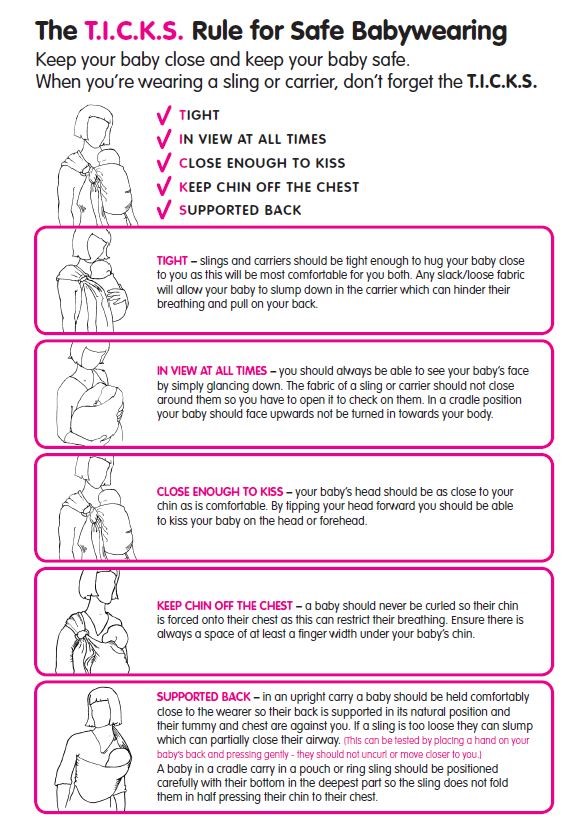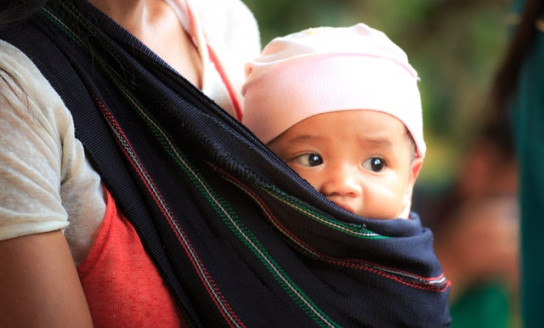About babywearing
Babywearing – wearing or carrying a baby in a sling or another kind of carrier – has been practised around the world for centuries.
All baby carriers - slings, wraps, pouches, soft carriers, packs and others – are designed to help you carry your baby hands-free. This eases the pressure on your arms and lower back by letting you carry your baby on your chest, hip or back.
Babywearing:
- leaves your hands free to do whatever you need to do
- gives you lots of skin to skin contact with your baby
- is said to strengthen the bond between parent/caregiver and baby
- lets babies see the world from up high
- may help babies fall asleep easier with the rocking or walking motion.
Baby carriers should:
- always be used in a way that means you can see baby’s face at all times
- be safe to use
- allow your baby’s hips to spread so their legs are straddling your body
- be comfortable for you to wear.
Parents and carers should take extreme care when using slings or pouches to carry babies that are under four months old, or weight less than 4kg.
Babies have suffocated while using slings, and they’re at risk if not placed correctly in a sling because they can’t move out of dangerous positions that block their airways.
Two positions are especially dangerous:
- if your baby is lying with a curved back, with the chin resting on the chest
- if your baby is lying with their face pressed against the fabric of the sling or the wearer’s body.
The Ministry of Health recommends you don’t use a sling or pouch if your baby is less than four months old, was premature, suffers from any type of breathing difficulty, or is unwell.
Types of baby carriers
There are many different kinds of baby carriers.
- Baby slings are pouches or strips of fabric, normally worn across your front and secured over your shoulder and around your waist. Baby slings don’t have identified openings for the baby’s legs.
- Wraps are also long strips of fabric that wrap around the body and are tied off around both shoulders.
- Front packs are padded carriers that have straps over both shoulders, and leg openings and bottom support for the baby. Young babies can face inwards and snuggle against you, and when your baby gets older many carriers allow you to face your baby outwards, so they can move more and see the world passing by.
- Soft padded carriers are worn on your front, and have a soft body and four straps that attach with buckles. Some are adjustable so you can wear them on your back or hip.
- Baby backpacks only go on your back, and normally have rigid frames. You can’t put young babies in them. A baby is old enough to ride in a baby backpack when they can sit up on their own (usually around six months). Ask your Plunket nurse or GP if you’re unsure whether your baby is old enough for a backpack.
It’s really important that if you use a baby carrier you do it safely.
Don’t use a carrier if:
- it’s described as being like a cocoon (that means your baby would be lying with a curved back, their chin resting on their chest)
- your baby lies with their face pressed against the fabric of the sling or your body
- it’s described as womb-like, or if it places the baby in the foetal position.
Don’t use a baby carrier while you’re smoking, or if you’re under the influence of alcohol or medication.
Read more about baby carriers
Safe babywearing
When you hold your baby in your arms, their head is supported, their airways open, and their back is straight. A baby carrier should support the baby the same way.
If you don’t place your baby correctly in a sling or other baby carrier, or you use it when they are too young, they’re at risk of suffocation. Babies are unable to move themselves out of dangerous positions that block their airways, so it’s essential you position them correctly and watch them closely while they're in it.
Here's how to wear a sling or carrier safely.

TICKS used with permission of the UK Sling Consortium
When you’re wearing a baby carrier, check that the baby’s face is clear, and the baby’s back is straight. Regularly check your baby for any signs of discomfort or distress.
If you see any of these things, remove the baby from the baby carrier or immediately reposition them:
- face covered or chin tucked in
- head turned to the side
- curled into a ‘C’ position
- grunting, wheezing, whistling breaths
- laboured or rapid breathing
- a dusky or ‘blue’ tinge on the baby’s skin
- ‘fussiness’, restlessness or squirming.
Other things to be aware of when using a baby carrier
- Never shake or bounce your baby while they’re in a carrier – don’t jump, or go for a jog or run. Shaking a baby can damage their neck, spine and/or brain.
- Never use a baby carrier while in a car – baby carriers don’t provide the protection car seats provide.
- Use appropriate carriers for your baby’s age and weight – carriers can’t be used until a baby can sit unassisted and has good head control.
- Don’t put loose items in the carrier that your baby could choke on, be poked by, or that could cover their face.
- Regularly check the carrier – fabric, seams, buckles/fasteners etc. - to make sure it’s sound.
- Be aware of what your baby can reach – especially if they’re in a back pack and you can’t see them.
- Constantly observe your baby while they’re in the carrier to make sure they’re in a good position and getting a good flow of air.
- Protect your baby from the elements – dress them appropriately for the weather and remember sunscreen in the summer.
If you wouldn’t do something with a baby in your arms, you probably shouldn’t do it while wearing your baby either – anything involving hot liquids, machinery, water, climbing, excessive movement, heat, or slippery surfaces, for example.
Choosing a baby carrier
There are no New Zealand safety standards for baby carriers. There are lots of different designs, and some are safer than others.
It’s a good idea to do some research on baby carriers before you buy – you may want to contact a babywearing group for advice too.
If you decide to use a baby carrier, take your baby with you when you buy it to make sure it’s a safe fit for them. If your partner is going to wear the carrier too, it needs to be adjustable to fit both of you as well. If the shop assistant can’t tell you about it and show you how to use it safely, go somewhere else.
Here’s what you should look for in a baby carrier.
For the baby’s safety and comfort
- Check the recommended age and weight to make sure the carrier is suitable for your child.
- Check your baby can breathe freely at all times.
- The carrier should provide support for the baby’s body, head and neck, and should hold your baby securely. This is especially important when you want to bend down or keep your hands free.
- Check the size of the leg holes to make sure they’re not so big they let your baby slip through.
- Check that inside seams don’t rub or chafe, and that there aren’t any:
- sharp edges
- choking hazards
- small loops, clips or buckles to trap little fingers and toes
- ripped seams
- loose or missing buckles.
- Breathable fabrics and gaps will help keep baby cool in summer (but you’ll need to dress your baby warmly in cooler weather).
Hold your baby over something soft — like a bed — when you put them in a carrier.
For your comfort
- Broad, well-padded shoulder straps that cross at the back will help distribute the baby's weight. The straps shouldn't pull too much on your neck or shoulders.
- A broad hip strap or waist strap will take some weight off your shoulders and limit sideways movement of the carrier, which adds stability.
- You should be able to easily adjust all straps with one hand, and the straps shouldn’t cut into the baby’s face or get in the way of their vision.
- While straps that tie up give more adjustment options, clips and buckles are usually easier to do up and release.
- Instructions should be easy to follow, especially if you haven’t used a baby carrier before.
- A machine-washable carrier will be easier to clean.
- Storage pockets are handy.
Never use a bag sling, or any carrier that allows the baby to lie with a curved spine. A bag sling has a narrow strap and is shaped like a bag. Babies can’t be placed in a safe position in a bag sling.
Baby slings
